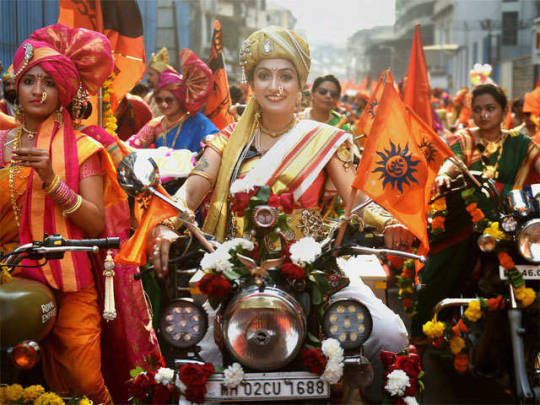#marathi language
Text
Marathi: The Pride and Prevalence of Language in Maharashtra
Marathi is language spoken by the Marathi people from Mharashtra state of India and is the official language of the state of Maharashtra. Marathi is the oldest of the regional literatures in Indo-Aryan languages, dating from about 1000 AD.

Marathi is an Indo Aryan language spoken by the Marathi people of western India (Maharshtrians). It serves as the official language of the state of Maharashtra, with roughly ninety million fluent speakers in Marathi language worldwide. Marathi ranks 4th in India with respect to the number of people who claim it as their primary language. Along with Bengali, Marathi is the oldest of the regional literatures in Indo-Aryan languages, dating from about 1000 AD. Marathi is at least fifteen hundred years old, and derives its grammar and syntax from Pali and Prakrit. The Marathi language was earlier known as Maharashtri, Maharathi, Malhatee or Marthi in ancient times. Some of the peculiar features of Marathi linguistic culture include Marathi drama, with its unique style of 'Sangeet Natak', scholarly discourses called 'Vasant Vyakhyanmala', Marathi folk dance called 'Lavani', and special editions of magazines for Diwali called 'Diwali anka'.
History
Marathi started on its own quite early, but literary began only in 13AD. Marathi can be traced back far beyond the 10th century. It descends from Sanskrit through Pali, Maharashtri and Maharashtra Apabhramsa. Maharashtri Prakrit was most popular amongst Prakrit languages and widely spoken in western and southern India. Today's Marathi and Kannada speaking parts were speaking Maharashtri from centuries.
The major dialect divisions of Marathi language have been Ahirani, Khandeshi, Konkani, Wadvali, Samavedi, Thanjavur & Namdev Marathi
Ahirani
Ahirani is spoken in the west Khandesh, North Maharashtara region. Ahirani is a language today spoken in the Jalgaon, Nandurbar, Dhule and Nashik (Baglan, Malegaon and Kalwan tehsils) districts of Maharashtra, India.
Khandeshi
Khandeshi is spoken in East Khandesh specifically in Yawal and Raver Talukas. Khandeshi is also called as Tawadi which is specifically spoken by Leva Patils dominant cast of east Khandesh.
Konkani
The constitution of India considers Konkani as one of the 21 official languages. In Maharashtra Konkani is considered a dialect of Marathi. The Marathi-Konkani feud and inclusion of Konkani in scheduled languages was mostly because of political reasons and status as Konkani as a separate language is disputed.
0 notes
Text
शिक्षा राज्य मंत्री डॉ. सुभाष सरकार ने मराठी भाषा में एआईसीटीई इंजीनियरिंग पुस्तकों का विमोचन किया
शिक्षा राज्य मंत्री डॉ. सुभाष सरकार ने मराठी भाषा में एआईसीटीई इंजीनियरिंग पुस्तकों का विमोचन किया
एनईपी में स्थानीय भाषाओं को प्राथमिकता देना सभी क्षेत्रीय भाषाओं के प्रति हमारी प्रतिबद्धता को दर्शाता है”
भारतीय भाषाओं में दी जाने वाली शिक्षा छात्रों को आसानी से समझने और शोध के लिए प्रोत्साहित करेगी – शिक्षा राज्य मंत्री
अखिल भारतीय तकनीकी शिक्षा परिषद (एआईसीटीई) ने मराठी भाषा में डिप्लोमा और स्नातक इंजीनियरिंग पाठ्यक्रमों के लिए परिणाम आधारित शैक्षिक पुस्तकों का आज शुभारंभ किया। केन्द्रीय…

View On WordPress
0 notes
Text
सनातन धर्म में कौन कौन आते हैं?
सनातन धर्म में कौन कौन आते हैं?
सनातन धर्म को हम जैसा समझते हैं, वो वैसा बिलाकुल भी नहीं हैं। हम ऐसा लगता है।
की सनातन धर्म में बस हिंदू ही आते हैं। लकिन ये बिलाकुल भी सत्य नहीं है? यद्यपि आज सनातन का पराया हिंदू से हैं।
यहां से ऐसा नहीं है, सनातन धर्म में सिख, बौद्ध, जैन धर्मावलंबी भी सनातन धर्म का हिसा है,
इसली ये बोलना गलत होगा की एक हिंदू धर्म से ही सनातन धर्म है, सनातन धर्म से ही सनातन धर्म है। .
ये सब धर्म सनातनी ही…

View On WordPress
#Bhiwani#Dharma#Hinduism#Hindus#History#home#Marathi language#Navagraha#Quotation#Sanatan Dharam Sanskrit Mahavidyalaya#Sanātana Dharma#shopsalary#The Companions & Co.#धर्म#हिंदू#हिन्दू धर्म#धर्मावलंबी#बौद्ध#स���ातन धर्म#सिख
0 notes
Photo




Marathi (𑘦𑘻𑘚𑘲)
1 note
·
View note
Text
what color do you associate with each language you speak?
#this is for a project so hELP#i realize there could be some arguments so argue away#desiblr#desi tag#desi#language#languageblr#linguistics#culture#spanish#french#hindi#telugu#marathi#tamil#foreign languages#surveys#research#russian#italian#german#korean#japanese#shri's posts
169 notes
·
View notes
Note
Do you agree with the popular conclusion in western linguistics that vowel length is not phonemic in modern Marathi (even if it’s indicated in writing)? I went to Maharashtra for the first time during my last visit to India and I did notice that vowel length was a lot more ambiguous than I expected in all cases, but especially in the distinction between अ and आ. But the mutual intelligibility between Maharashtrian Marathi and my dialect, Thanjavur Marathi, is not great, so wtf do I know
This sounds like one of those things that we don't really pay attention to as native speakers, but would be very important for someone learning the language!
However, I do think that there is plenty of ambiguity between short and long vowels, especially इ/ई and उ/ऊ. The example that comes to mind for me is that the -वू suffix in Marathi, where say धावू नकोस is pronounced closer to धाउ नकोस.
I can't say I've noticed an ambiguity between अ and आ though. I think some examples might help there.
I'm no linguist, but this was a really cool ask! Thank you!
31 notes
·
View notes
Note
oooh is it Holi tomorrow? :DD can you give us some ideas or headcanons about James celebrating Holi with his parents/Sirius/Harry? <33
Honestly, depending on a few factors, everyone celebrates Holi on a different day (the traditions for Holi are different depending on the sect of Hinduism and region of celebration as well). Also, North Indian होली and Maharashtrian होळी (search up the differences in pronunciation, it's a bit hard to describe) are two completely different religious holidays. The Hindi होली (ho-lee) is equivalent to the Marathi "ranga panchami" (ranga- colour, panchami- fifth day of a lunar cycle). As far as I know, the Marathi होळी doesn't have an equivalent.
The traditions I'm going by are my family traditions— the Marathi traditions of my region— so i hope you enjoy. Let's goooo!
Oh yeah, this is before Harry turns eleven and goes to Hogwarts.
The day of होळी signifies the first day of spring in Maharashtra. Every year, the members of the Black-Potter family start the day by watching the sunrise together with cups of spicy chaha (marathi for chai).
The day is pretty much the usual, except for food. James cooks up a storm in the kitchen, making all the pancha pakwaan (pancha- five, pakwaan- dishes) with puran poli (a sweet flatbread), three different vegetables, rice, amti (somewhat like daal, either drunk from the bowl or poured over rice), and a traditional dessert. They invite the Weasleys, the Marauders and the Longbottoms over, and have a veritable feast for lunch and dinner. A very chaotic affair, but the Black-Potters love it.
All three of them absolutely adore panchamrut (pancha- five, amrut- nectar of the Gods. It's made of five ingredients- milk, ghee, sugar, curd, honey). Once James is done with his pooja and the naividya (the first morsel/sip of any food/drink is always offered to the Gods), the three of them pounce on the drink with all the vigour of someone who hasn't had anything to eat for days.
As the evening draws closer, Harry, the Weasley kids, Neville, and Lily and Remus out to the woods that surround the house and collect dried wood for. Meanwhile, James, Sirius and Peter gather the panchamrut and a bite each of the pancha pakwaan, and ready the porch for lighting a safe fire with the help of the Molly, Arthur, Augusta, Alice and Frank.
Just as the sun sets, the bonfire is lit, and the blaze reaches high into the sky within minutes, helped along by magic. Everyone sits around it in a circle, closing their eyes and praying— the fire signifies the destruction of the bad energy of the previous year and the purification of the soul for a better new year. Holi is the first day of spring, a mark of new beginnings, a symbol of clean slates and fresh starts. The Holi fire is where you throw all your baggage of the last year so it burns till it is gone, to prepare yourself for the upcoming year.
The pancha pakwaan and panchamrut are poured into the fire to loud cheers from the children, and then the real festivities begin. Everyone walks around the fire in a circle, howling at the top of their lungs. The sounds are slightly terrifying, especially when the darkness really sets in and the only light is the massive bonfire, but Harry loves the ferality of the entire thing. It's primal, the way the war cries rise up with the fire, echoing throughout the massive grounds of Potter Manor like the echoes of screaming ghosts.
Sometimes, Harry, Ginny and the Weasley twins start war dances instead of the howling. Those times, Bill and Charlie eagerly join in along with James, Lily and Alice, and the hard and fast thumping of their feet on the packed mud porch makes it seem like an earthquake is cracking the ground open.
Other times, they write their mistakes, insecurities, bad thoughts and regrets of the past year onto slips of paper and throw them into the fire, to signify the new start. Last year does not matter anymore; it is done and you cannot change it. You can have a new beginning, though, and Harry vows every year that he will be a better person.
James loves these times, where everyone he cares about is close to him and glowing with happiness. Holi is his favourite festival, because it is the day he and Sirius kissed for the first time. It is the day he remembers with fondness— childhood years spent with his parents and grandparents and cousins in a crowded wada (kind of like a palace but the size varies from anywhere between four bedrooms to like 70), sneaking panchamrut from under his mother's nose, dancing Garba around the fire with his Gujju friends in India, the day the Potter family first moved to Britain right before his 11th birthday. People expect his favourite festival to be Diwali or Ganpati Chaturthi because they are loud and huge and phenomenal celebrations, but his favourite is this— all his favourite people in the same place with the same happy smile and the same traditions that he loved when he had blood family.
Holi is a festival for families and loved ones, and the Black-Potters have a lot of love to go around. Family isn't defined by blood, after all.
#sirius black#harry potter#james potter#prongsfoot#bambibelle#marauders headcanon#this took such a long fucking time bro#i had no idea what to write and what not to write#and english is such an inadequate language#so many Marathi words that are untranslatable uGH#holi#marathi holi#होळी#desi harry potter#desi james potter#indian harry potter#indian james potter#indian festival#im sorry it took such a long time to answer but yeah#hope you like it!!!
46 notes
·
View notes
Note
English. Bullshit. Tomfoolery. Do we add Clownery to this year, beautiful? 🫄
clownery fluent since birth 💯💯 adding bitchery ive never complained so good
#english#marathi#french#half of#hindi#so i don't count hindi#adding#arabic#gave up on irish long time back bc theres nobody 2 talk to.#languages#answered#logan tag#on posts
10 notes
·
View notes
Text
You know that episode in The Big Bang Theory in which Bernadette and Raj do a parody of an Indian dance number? The lyrics do sound ridiculous . . . in English. That's the thing. I don't know why, but Indian song lyrics that sound absolutely bizarre when translated to English, sound perfectly normal, nay beautiful, in the original Indian versions of the songs. I guess Indian languages just carry the hyperboles and metaphors with a certain elegance.
P. S. When I say Indian languages, I don't necessarily mean that they are spoken only by Indians or by people of Indian origin.
#tbbt#the big bang theory#raj koothrappali#bernadette rostenkowski#indian songs#indian languages#bollywood#tollywood#kollywood#kunal nayyar#melissa rauch#lyrics#music#tamil#telugu#hindi#malayalam#kannada#bengali#marathi#assamese#urdu
17 notes
·
View notes
Text
The Importance of Multilingualism in Maharashtra: Preserving Regional Languages
Marathi is an Indo Aryan language spoken by the Marathi people of western India (Maharshtrians). It serves as the official language of the state of Maharashtra, with roughly ninety million fluent speakers in Marathi language worldwide. Marathi ranks 4th in India with respect to the number of people who claim it as their primary language. Along with Bengali, Marathi is the oldest of the regional literatures in Indo-Aryan languages, dating from about 1000 AD. Marathi is at least fifteen hundred years old, and derives its grammar and syntax from Pali and Prakrit.

Marathi started on its own quite early, but literary began only in 13AD. Marathi can be traced back far beyond the 10th century. It descends from Sanskrit through Pali, Maharashtri and Maharashtra Apabhramsa. Maharashtri Prakrit was most popular amongst Prakrit languages and widely spoken in western and southern India. Today's Marathi and Kannada speaking parts were speaking Maharashtri from centuries. A gradual process of change and modification in the spoken language has led to the rise of the present Marathi.
The major dialect divisions of Marathi language
Khandeshi
It is spoken in East Khandesh specifically in Yawal and Raver Talukas.
Ahirani
Ahirani is spoken in the west Khandesh, North Maharashtara region. At present, it is spoken in the Jalgaon, Nandurbar, Dhule and Nashik (Baglan, Malegaon and Kalwan tehsils) districts of Maharashtra, India.
Konkani
This division of Marathi language is spoken in the konkan region of Maharashtra state.
Samavedi
Samavedi is spoken in the interiors of Nala Sopara and Virar region to the north of Mumbai in the Vasai Taluka, Thane District of Maharashtra.
Wadvali
It was primarily spoken by Wadvals, agricultural plot owners of the Naigaon, Vasai region .
Thanjavur and Namdev Marathi is spoken by many Southern Indians. This language has evolved from the time of occupation of the Marathas in the Thanjavur in southern Tamil Nadu. It has speakers in parts of Tamil Nadu, Andhra Pradesh and Karnataka.
Dangii is spoken near the Maharashtra-Gujarat border
Judaeo-Marathi is spoken by the Bene Israel Jews
Malvani is spoken in southern Konkan near Malvan
Kadodii is spoken near Vasai
0 notes
Text

Realizing now i spelled piece wrong. there is no hope for me...
Anyways hello. Marathi time . There will be no complaints .

18 notes
·
View notes
Note
you seem well versed in marathi language, can you recommend me modern day books in marathi that i can enjoy? i don't mind the genre but I'm a teenager so most of the marathi literature is hard to pick up for me (although i respect it immensely) i believe literature, music and active pop culture is the best way to promote a langauge rather than giving speeches at political venues. I'd like to read more of your own work as well because i saw a post and it was amazing! it's fine if you can't recommend anything too!
p.s. i love your language blog
I don't know enough about Marathi literature to recommend you anything!
I think the closest I know is Cobalt Blue by Sachin Kundalkar, who also directed its film adaptation. It's about a brother and a sister who fall in love with the same man, and it was released in 2013.
You're absolutely right about pop culture being the best way to promote a language, and I wish Marathi had a more active diverse pop culture scene. Maybe in time? I'd love to help in any way I can!
Thank you so much for your kind words about Survive to Read! You can read more of my literature over at Sulfurous Dreamscapes and its associated substack Sulfur Dreams!
Thank you so much for sending me this! ❤️
11 notes
·
View notes
Text
Devanagari script
#Devanagari#IndianLanguages#Script#india#sanskrit#Hindi#Marathi#Nepali#language history#Language Art
3 notes
·
View notes
Text
Learning Telugu as a Maharashtrian be like;
Mi means "I or me" in Marathi while it means "you or your" in Telugu.
*gives up immediately*
#JK I'm determined to learn this damn language#Na Peru Sakshi#SEE I'm fucking fluent#😭😭😭😭#send help pls#Like aren't we supposed to be neighbours why are our languages so different!!????#(ik it's because Marathi is an Indo-Aryan lang while Telugu is Central-Dravidian)#But STILL
86 notes
·
View notes
Text
Presenting, an apple.
Some Indian languages: What do the Persians call it? Yeah, I'm gonna go with that.
Other Indian languages: What do the English call it? Yeah, I'm gonna go with that.
Marathi: :)
All other Indian languages: 👀
Marathi: It's clearly a 'travelmoon'. :) It's like a little moon I can carry when I travel.
Gujarati: *furiously takes notes*
#marathi#hindi#india#indian languages#langblr#probably not accurate but look this was really funny in my head#gujarati#weird that neither kulkarni nor wiktionary record an etymology for सफरचंद
234 notes
·
View notes
Text
Resource List for Learning Marathi
Hello! Do you want to learn Marathi but don't know where to start? Then I've got the perfect resource list for you and you can find its link below! Let me know if you have any suggestions to improve it. Here is what the resource list contains;
"Handmade" resources on certain grammar concepts for easy understanding.
Resources on learning the script.
Websites to practice reading the script.
Documents to enhance your Marathi vocabulary.
Notes on Colloquial Marathi.
Music playlists
List of podcasts/audiobooks And a compiled + organized list of websites you can use to get hold of Marathi grammar
#india#langauge learning#language#language resources#discord server#langblr#desiblr#studyblr#south asia#south asians#culture#indian#marathi#mumbai#maharashtra#maharashtrian food#bombay#india news#resources#useful
97 notes
·
View notes